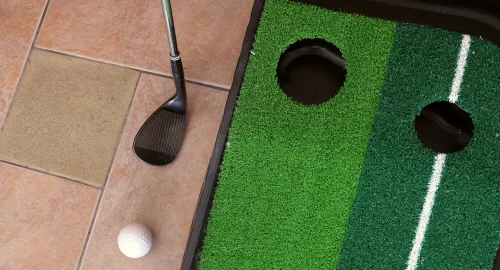Golf is one of the most rewarding sports you’ll ever play—but let’s be honest, it can also feel overwhelming when you’re just starting out. There’s a swing to figure out, rules to learn, clubs to choose from, and dozens of tips flying at you from all directions.
With so much noise, how do you actually get better? The answer is simpler than you think: track your game progress.
When you start keeping tabs on your strengths and weaknesses, you turn practice from guesswork into a clear improvement plan. Instead of standing on the range “hoping” to fix something, you’ll know exactly what needs attention.
Even small insights—like realizing you average 40 putts a round—can shift your practice in the right direction and shave strokes off your score. In this guide, we’ll cover the most important stats to track as a beginner, simple ways to measure them, and resources to improve. By the end, you’ll know exactly what to track and the fastest ways to shoot lower scores.
Why Tracking Matters for Beginners
Beginners often think the fastest way to improve is to buy new clubs or spend hours on the range. While equipment and practice help, the real key is clarity.
Tracking your game gives you a clear picture of what’s working—and what’s holding you back. Here’s why tracking your progress is so important:
- Replace guesswork with facts: Instead of thinking “my driver is the problem,” you’ll know whether it’s actually driving accuracy, putting, or penalty shots that cost you the most strokes.
- Keeps you motivated: Improvement in golf takes time. Tracking lets you see progress in black and white, even when your score doesn’t drop right away.
- Helps you practice smarter: Once you identify weak spots, your range sessions and practice routines can focus on what truly matters.
- Builds confidence: Knowing your strengths gives you trust in parts of your game you can rely on during pressure moments.
At the end of the day, golf is a game of progress, not perfection. By tracking your game from the start, you’ll create a clear roadmap to improvement and avoid wasting years working on the wrong things.
Golf For Beginners: What To Track
Tracking your game doesn’t need to be complicated.
Start with a few core metrics that give the clearest picture of your performance. These will highlight where you’re losing strokes and where to focus your practice.
Here are the key stats to track:
- Fairways Hit: Keep track of how many drives land in the fairway. If you’re missing left or right consistently, it points to driver swing path or setup issues.
- Greens in Regulation (GIR): Count how many times you reach the green in the expected number of strokes (ex. hitting the green in two on a par 4). A low GIR means approach shots are costing you strokes. You might need to smooth out your tempo or eliminate fat shots.
- Putts per Round: Circle the number of putts on your scorecard. If you’re averaging over 36, it signals that your putting needs attention. These putting tips should help reduce your total shots on the green fast.
- Up-and-Downs: Record whether you save par when missing the green. This reflects your short game skill, which is crucial for lowering scores.
- Penalty Shots: Track how often penalty areas, out-of-bounds, or unplayable lies hurt your round. Too many penalties usually mean poor decisions or risky targets.
- Overall Score Trends: Don’t just record the final number but look at trends from your handicap. You can also compare front vs. back nine, or note “blow-up holes.” These patterns reveal if fatigue, nerves, or poor decision-making are creeping in.
Tracking these stats gives you a snapshot of your game in minutes. With this information, you’ll know whether to spend your next range session on driver accuracy, short game, or putting instead of guessing.
How to Track Progress Easily
Once you know what to track, the next step is building a simple system to record it consistently. You don’t need spreadsheets or complex scorecards—just a method that works for you.
Easy ways to start tracking:
- Scorecards & Notes: Write F (fairway), G (green in regulation), P (number of putts), and circle penalty strokes. At the end of each round, tally them up and log in a journal or note on your phone to track trends.
- Weekly Review: Take 10 minutes to reflect at the end of the week. Which stat improved? Which one needs attention? This helps you adjust your next practice session to address the biggest areas for improvement
Performance Golf App

If you’re working on building a better swing on the range, the Performance Golf App is an incredible tool. It’s more cost-effective than working with a coach, and our SwingFix AI makes it easier than ever to analyze what’s going on in your swing.
Here’s how you can use the app to improve your swing:
- Record swing videos and upload directly in the app.
- Get personalized feedback from 17 data points to address the biggest issues to improve.
- Measure your progress each time you record to make sure you’re fixing the root flaw that will improve your swing fast.
Plus, unlimited swing review with a dedicated VIP coach for 30 days!
Using Performance Golf Features to Improve
Collecting data is only half the battle—the real breakthrough comes when you use it to actually improve. That’s where Performance Golf’s tools come in.
The Performance Golf App helps you:
- Turn weaknesses into action: If you’re missing fairways, the app provides drills and swing tips designed to improve accuracy.
- Store progress: Upload swing videos and review them side-by-side with past versions to see improvements.
- Stay structured: Instead of jumping from one random drill to another, the app guides you through tailored practice plans.Stay structured: Instead of jumping from one random drill to another, the app guides you through tailored practice plans.
- Gain confidence: By tracking both stats and swing progress, you’ll know your game is trending in the right direction.
Want even more help? Our Exclusive VIP Golf School takes it a step further. These programs are a once-in-a-lifetime, immersive in-person golf experience to find and fix your root swing flaw in just a couple days.

Practical Tips for Beginners Golfers to Stay Consistent
Tracking stats and using tools is great, but only if you stay consistent. Here are a few ways to make it easy and enjoyable:
- Celebrate small wins: Did you shave three putts off your last round? That’s progress—acknowledge it.
- Focus practice time: Spend 70% of your effort on the stat that needs the most improvement. Programs like One Shot Slice Fix or Simple Strike Sequence can help with trouble areas of most amateur golfers.
- Compare against yourself: Don’t worry about how far your buddy hits it. Track your own trends to stay motivated to hit your golf goals.
- Lean on structure: Use Performance Golf programs so practice sessions aren’t wasted on random drills.
- Stay patient: Even if you’re working hard, changing your swing can take time. You might have it dialed on the range, but it can take longer to show up on the course. Keep with it, even if you aren’t seeing the results yet.
The goal isn’t perfection, it’s steady progress. By keeping it simple, you’ll build momentum and confidence with every round.
Golf For Beginners: Start Small, Improve Faster
The fastest way to get better at golf isn’t hitting more balls, it’s tracking the right things and improving with a plan.
By keeping tabs on fairways, greens, putts, and penalties, you’ll know exactly what to work on. With the Performance Golf app, coaching, or even a VIP school, you’ll have the tools and guidance to turn those stats into lasting improvement.
Remember: the game is about progress, not perfection. Start small, stay consistent, and use Performance Golf to take the guesswork out of your journey.

